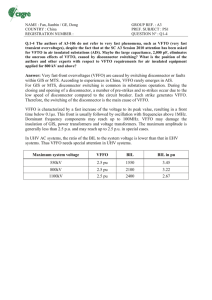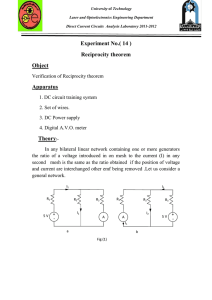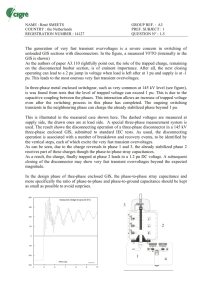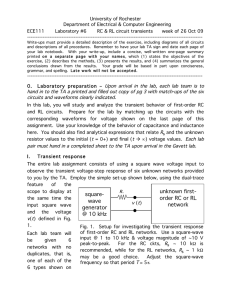Electromagnetic Disturbances of the Secondary Circuits in Gas
advertisement
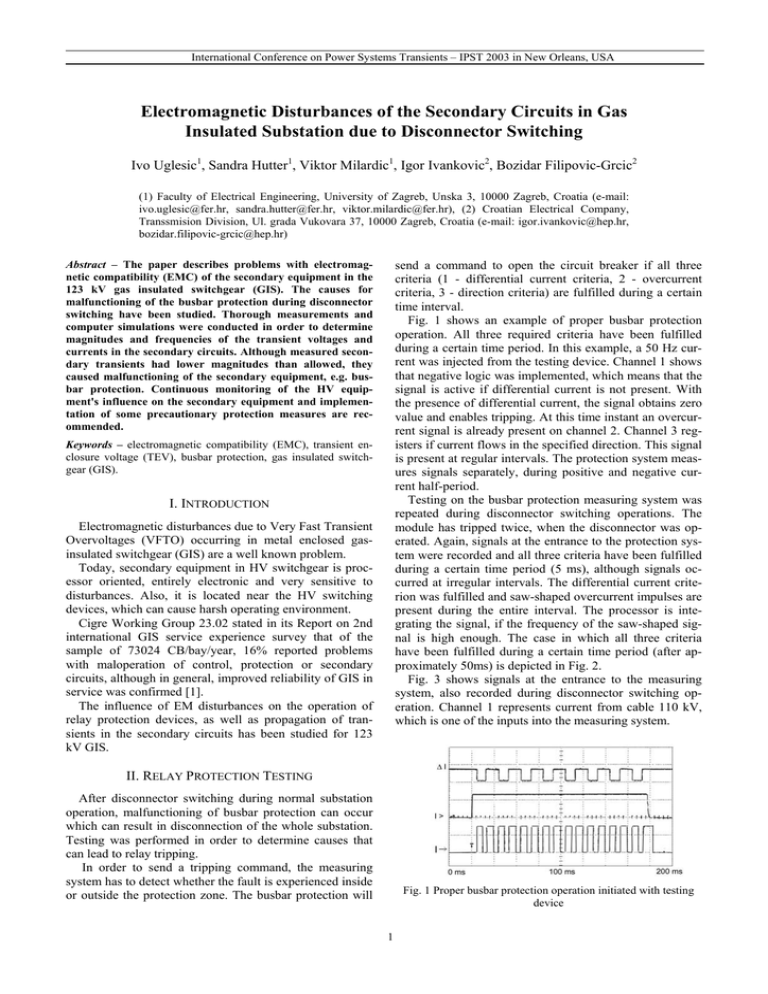
International Conference on Power Systems Transients – IPST 2003 in New Orleans, USA Electromagnetic Disturbances of the Secondary Circuits in Gas Insulated Substation due to Disconnector Switching Ivo Uglesic1, Sandra Hutter1, Viktor Milardic1, Igor Ivankovic2, Bozidar Filipovic-Grcic2 (1) Faculty of Electrical Engineering, University of Zagreb, Unska 3, 10000 Zagreb, Croatia (e-mail: ivo.uglesic@fer.hr, sandra.hutter@fer.hr, viktor.milardic@fer.hr), (2) Croatian Electrical Company, Transsmision Division, Ul. grada Vukovara 37, 10000 Zagreb, Croatia (e-mail: igor.ivankovic@hep.hr, bozidar.filipovic-grcic@hep.hr) send a command to open the circuit breaker if all three criteria (1 - differential current criteria, 2 - overcurrent criteria, 3 - direction criteria) are fulfilled during a certain time interval. Fig. 1 shows an example of proper busbar protection operation. All three required criteria have been fulfilled during a certain time period. In this example, a 50 Hz current was injected from the testing device. Channel 1 shows that negative logic was implemented, which means that the signal is active if differential current is not present. With the presence of differential current, the signal obtains zero value and enables tripping. At this time instant an overcurrent signal is already present on channel 2. Channel 3 registers if current flows in the specified direction. This signal is present at regular intervals. The protection system measures signals separately, during positive and negative current half-period. Testing on the busbar protection measuring system was repeated during disconnector switching operations. The module has tripped twice, when the disconnector was operated. Again, signals at the entrance to the protection system were recorded and all three criteria have been fulfilled during a certain time period (5 ms), although signals occurred at irregular intervals. The differential current criterion was fulfilled and saw-shaped overcurrent impulses are present during the entire interval. The processor is integrating the signal, if the frequency of the saw-shaped signal is high enough. The case in which all three criteria have been fulfilled during a certain time period (after approximately 50ms) is depicted in Fig. 2. Fig. 3 shows signals at the entrance to the measuring system, also recorded during disconnector switching operation. Channel 1 represents current from cable 110 kV, which is one of the inputs into the measuring system. Abstract – The paper describes problems with electromagnetic compatibility (EMC) of the secondary equipment in the 123 kV gas insulated switchgear (GIS). The causes for malfunctioning of the busbar protection during disconnector switching have been studied. Thorough measurements and computer simulations were conducted in order to determine magnitudes and frequencies of the transient voltages and currents in the secondary circuits. Although measured secondary transients had lower magnitudes than allowed, they caused malfunctioning of the secondary equipment, e.g. busbar protection. Continuous monitoring of the HV equipment's influence on the secondary equipment and implementation of some precautionary protection measures are recommended. Keywords – electromagnetic compatibility (EMC), transient enclosure voltage (TEV), busbar protection, gas insulated switchgear (GIS). I. INTRODUCTION Electromagnetic disturbances due to Very Fast Transient Overvoltages (VFTO) occurring in metal enclosed gasinsulated switchgear (GIS) are a well known problem. Today, secondary equipment in HV switchgear is processor oriented, entirely electronic and very sensitive to disturbances. Also, it is located near the HV switching devices, which can cause harsh operating environment. Cigre Working Group 23.02 stated in its Report on 2nd international GIS service experience survey that of the sample of 73024 CB/bay/year, 16% reported problems with maloperation of control, protection or secondary circuits, although in general, improved reliability of GIS in service was confirmed [1]. The influence of EM disturbances on the operation of relay protection devices, as well as propagation of transients in the secondary circuits has been studied for 123 kV GIS. II. RELAY PROTECTION TESTING After disconnector switching during normal substation operation, malfunctioning of busbar protection can occur which can result in disconnection of the whole substation. Testing was performed in order to determine causes that can lead to relay tripping. In order to send a tripping command, the measuring system has to detect whether the fault is experienced inside or outside the protection zone. The busbar protection will Fig. 1 Proper busbar protection operation initiated with testing device 1 International Conference on Power Systems Transients – IPST 2003 in New Orleans, USA Operated disconnector Tripping Fig. 4 One-line diagram of 123 kV GIS Fig. 2 Busbar protection operation initiated during disconnector switching operation. E6 E5 DC circuits Cable protection circuits Busbar protection circuits E2 E1 Command kiosk Current tranformer Gas insulated switchgear Differential protection control circuits Current tranformer measuring GIS enclosure point Cable sheaths Fig. 5 Location of measuring points Ch.1 Ch.2 Ch.3 Ch.4 - I1 U1 I2 U2 current from cable 110 kV, secondary voltage from module RWT80, current from transformer secondary 110/10 kV, voltage from transformer secondary 110/10 kV. circuits, busbar and cable protection circuits, and DC circuits). A. External Transients at GIS/cable junction Fig. 3 Signals at the entrance in the measuring system (with superimposed HF interference). During switching operation in the GIS, restrikes between contacts generate surges that propagate inside and outside the enclosure. Transients that appear on the outer side of the GIS cause transient enclosure potential rise (TEVR). Whole series of restrike sequences were recorded during disconnector closing and opening. During measurements, more than a hundred repetitions of this phenomenon were recorded (Fig. 6). However, this number depends on the chosen trigger level, hence the actual number is even greater. It can be assumed that the duration of the whole process is more than 300 ms. It can be observed that HF interference is superimposed on 50 Hz frequency signal. Channel 2 represents voltage which the module sends as output signal in the measuring system. Channels 3 and 4 represent current and voltage from the secondary side of the power transformer. On-site testing has demonstrated that disconnector switching operation can lead to the relay protection tripping. III. MEASUREMENTS B. Transmitted Voltages and Currents in Protection Control Circuits Thorough measurements were conducted in order to determine magnitudes and frequencies of the transient voltages and currents in the secondary circuits [2]. Fig. 4 shows a one-line diagram of the 123 kV GIS testing configurations. During on-site EMC testing, applied voltage or current interference should not damage or put at risk normal operation of the equipment. Transient enclosure voltage (TEV), induced impulse currents, transmitted voltages and currents in the secondary circuits were measured during disconnector switching operations located in the line feeder bay, at the following points (Fig. 5): enclosure at the point of GIS/cable junction and cable sheaths; ground straps; current transformer terminals; secondary circuits (differential protection control Impulse voltages and currents are transmitted in the measuring, protection and control circuits via conductive, inductive or capacitive coupling, and at the highest frequencies via radiative coupling (antenna effect) [3]. Fig. 7 shows typical a) voltage and b) current oscillograms recorded in current control circuits located in the busbar protection kiosk, caused by a single restrike (maximal measured voltage and current magnitudes at this location were 80 V and 20 A, respectively). A wide band of frequencies can be observed in Fig. 7. However, the voltage oscillates with two dominant frequencies around 11 MHz and 48 MHz. 2 International Conference on Power Systems Transients – IPST 2003 in New Orleans, USA 50 40 30 Voltage U (V) 20 10 0 -10 -20 -30 -40 -50 0 0,2 0,4 0,6 a) 0,8 Tim e 1 1,2 t (m icrosec) 1,4 1,6 1,8 2 7.0 U[V] 5.6 4.2 2.8 1.4 0.0 a) 95 samples, t = 260 ms 0 10 20 f (MHz) 30 40 50 60 10 8 6 Current I (A) 4 2 0 -2 -4 -6 -8 -10 b) 0 0,2 0,4 0,6 0,8 1 1,2 Time t (microsec) 1,4 1,6 1,8 2 I (A) 1.2 0.8 0.4 0.0 -0.4 0 b) 100 samples, t = 234 ms 20 40 f (MHz) 60 80 100 Fig. 6 External transient voltages at the GIS/cable junction (curve A) and on the cable sheaths (curves B, C and D) during disconnector a) closing b) opening Fig. 7 a) Voltage and b) current during disconnector switching recorded in current control circuits located in busbar protection kiosks Dominant frequencies observed on the current diagram are around 48 MHz and 86 MHz. The entire disconnector switching operation, lasts a few hundred milliseconds. More than a hundred impulses with a duration of a few microseconds, are repeated with pauses of differnet durations in a range of milliseconds. The overcurrent relay module takes into account RMS current value, so in some cases multiple repetition of the current impulses can be interpreted as a signal that led to busbar protection tripping. frequency of 50 MHz occurring at different locations and with different magnitudes. In some cases, currents had two dominant frequencies, one responding to the voltage frequency and the other twice as high. Table I gives an overview of maximal transient voltages' and currents' magnitudes, with their corresponding dominant frequencies, measured at different locations. According to standards IEC 801-4 [4] and IEC 17C 102 [5], testing procedures carried out on the secondary equipment have an acceptable disturbance level up to 2 kV. C. Overview of Measurement Results All measured transients in the secondary circuits had magnitudes within the boundaries specified by the above mentioned standards. Measurement results have shown that in all cases high frequency voltages and currents appear, with a dominant 3 International Conference on Power Systems Transients – IPST 2003 in New Orleans, USA Table I Maximal transient voltage and current magnitudes with dominant frequency(s). UN - voltage in normal operation, Û - peak value of transient voltage, fU - voltage dominant frequency(s), IN - current in normal operation, Î - peak value of transient current, fI - current dominant frequency(s). Location Enclosure Cable sheath Command kiosk Current transformer Busbar protection kiosk Cable protect. kiosk Comment current circuits diff. busbar protection DC circuit 220V bay E5 bay E1 voltage circuits current circuits DC circuit 24 V voltage circuits UN [V] Û [V] 12800 14380 400 240 ± 80 368 228 76 80.5 ± 30 56 0 0 0 0 ± 110 0 0 100 3 0 ± 12 100 3 Additionally, computer simulations were performed on the model, containing three phases in one encapsulation and taking into account mutual coupling between phases, with the help of the EMTP-ATP program. Inner VFTO and transmitted voltages in the secondary circuits were calculated during disconnector switching operations, for the same substation layouts on which measurements were carried out (Fig. 4). ˆI [A] fI [MHz] 20; 47 20; 47 23; 47 23 48 50 3; 18 48 27; 52 16 1 1 1 0 1 - 90 115 105 22 20.5 - 23; 47 48; 90 50; 70 18 48; 86 - Pi = 1.015 g 0.827 (MW ) (2) b) Burning: Pb = 15 g 2.5 (MW ) (3) The time constant Θ determines the rate of change with which the arc conductance obtains its stationary value. In the calculations a constant value of Θ (g) = 1µs was assumed, because of its negligible influence on the very fast transients. Parameters Pi, Pb and Θ are selected as recommended in [8]. The power transformer was modeled, as proposed in [9] with the total equivalent capacitance: A. Applied Models Bus ducts (Fig. 8) were represented as lossless distributed parameter transmission lines [6] with the following high-frequency surge impedance matrix, calculated with the support routine CABLE CONSTANTS in the EMTPATP program [7]: CT = C e + C b = C g C s + C b [Ω] (4) where Cs represents equivalent series capacitance of the winding, Cg is the shunt capacitance between winding to the grounded core and transformer tank, and Cb is capacitance of the terminal bushing. Cs and Cg were computed from the transformer geometry according to [10]. For the considered transformer with the nominal power of 40 MVA and with continuous disc winding, computed values were Cs = 66 pF and Cg = 3700 pF. The leakage inductance of the winding was 174 mH. Inner transients are transmitted to the outer side of the GIS enclosure at the GIS/cable junction and at the gas to air bushings. The model of the gas to air bushing contains an ideal transformer that enables connection of three transmission lines: the bus duct inside enclosure, the enclosure outer side (surge impedance to ground) and an overhead wire, as shown in Fig.9. A similar approach was used for modeling of the GIS/cable junction. The enclosure, ground straps and simplified earthing grid are modeled for calculation of TEV from their surge impedance and corresponding length [6]. Electrical arc in the disconnector during sparking was simulated with its conductance-dependent parameters described with the Cassie and Mayr arc equation: i2 dg 1 = ( s − g) dt Θ( g ) P( g ) IN [A] Parameters P(g) and Θ(g) are conductance dependent. P(g) is defined for two rates that correspond to the ignition and burning phase: a) Ignition: IV. COMPUTER SIMULATIONS 105.6 18.8 18.8 Z S = 18.8 105.6 18.8 18.8 18.8 105.6 fU [MHz] (1) where g is the arc conductance, is is the arc current, P is the arc cooling power and Θ is the arc thermal time constant. rv = 0.04 m, rs =0.144 m Ru = 0.3 m Fig. 8 Bus duct cross-section 4 International Conference on Power Systems Transients – IPST 2003 in New Orleans, USA B. Calculation Results Overhead wire Evaluation of calculated results for external transients has to take into account complexity of the model and unsymmetrical geometry of components outside the enclosure. Usually, for the substations that are already in operation it is difficult to obtain all necessary details for more accurate calculations. Measured and calculated results for the external transients were compared in the time and frequency domains (Fig.10 and Fig. 11). Results have shown that inner transients in this case do not place high dielectric stress on adjacent equipment and the transformers' insulation. However, due to their high frequency and multiple repetition in a short time period they are a source of disturbances to the secondary circuits. SF6 insulated bus duct 1:1 enclosure outer side Fig. 9 Model of the gas to air bushings Surge impedance for each enclosure section was calculated from its medium height above the ground and its outer radius. U[kV] 4 4 3 kV] 3 2 2 1 1 0 0 -1 -1 -2 -2 -3 -3 0 300 600 900 1200 1500 0 1800 300 600 900 1200 1500 1800 t (ns) t (ns) a) Measured Umax = 3.6 kV a) Measured Umax = 3.8 kV 4000 4000 [V] [V] 3000 3000 2000 2000 1000 1000 0 0 -1000 -1000 -2000 -2000 -3000 -3000 -4000 0.0 1.5 1.2 0.9 0.6 0.3 [us] -4000 0.0 1.8 1.5 1.2 0.9 0.6 0.3 [us] (file TR49_VARD5E.pl4; x-var t) v:PLASTB (file TR49_VARD5E.pl4; x-var t) v:OKLOPC b) Calculated Umax = 3.4 kV b) Calculated Umax = 3.4 kV 0.7 0.9 [kV] [kV] 0.5 0.6 0.3 0.3 0.1 0.0 -0.1 0 10 20 30 40 50 0 60 10 20 30 40 50 60 f (MHz) f (MHz) c) Frequency spectrum of measured voltage c) Frequency spectrum of measured voltage 800 [V] 900 [V] 750 600 600 450 400 300 200 150 0 0 0 10 20 30 40 50 0 60 10 20 30 40 50 60 f (MHz) f (MHz) d) Frequency spectrum of calculated voltage d) Frequency spectrum of calculated voltage Fig. 11 Transient voltage on cable sheat Fig. 10 Transient enclosure voltage 5 1.8 International Conference on Power Systems Transients – IPST 2003 in New Orleans, USA Computer simulations can be used for assessment of the possible transient level and their frequency spectrum that can occur in the GIS. The frequency spectrum of calculated transient enclosure voltage differs somewhat from that measured, although a dominant frequency of around 50 MHz is often measured in other cases (Table I). Arrangement and modeling of the ground straps has a considerable influence on the calculation of the external transients, and especially on the frequency spectrum, due to the wave reflections at short distances. It can be observed that the transients are strongly damped in both cases. current levels in the secondary circuits. In the GIS operation continuous monitoring of the HV equipment's influence on the secondary equipment and implementation of some precautionary protection measures are recommended. Attention should be focused on the implementation of protection measures, electromagnetic disturbance mitigation methods and on site EMC equipment testing. Comparison of the external transients computer simulations with field measurements showed that calculations could be used for assessment of the overvoltage level that may occur in the GIS. REFERENCES VI. CONCLUSIONS [1] T.M. Chan, F. Heil, D. Kopejtkova, P.O' Connell, J.-P. Taillebois, I. Welch, "Report on Second International Survey on High Voltage Gas Inslated Substations (GIS) Service Experience", Paper 23-102, CIGRE Paris, 1998. [2] I. Uglesic, V. Milardic, S. Hutter, I. Ivankovic, " Electromagnetic compatibility in secondary circuits in Substation Trpimirova 110/20 kV ", Zagreb, March 2002. [3] WG 36.04, "Guide on EMC in power plants and substations", Paris, December 1997. [4] IEC 801-4 : "Electromagnetic compatibility for industrial-process measurement and control equipment. Part 4. Electrical fast transients/burst requirements", 1988. [5] IEC 17C 102: Committee Draft 17C (Secretariat)102, "Electromagnetic compatibility (EMC) for secondary systems in gasinsulated metal enclosed switchgear for rated voltages of 72.5 kV and above", 1991. [6] J.A. Martinez, D.Povh, P. Chowdhuri, R. Iravani, A.J.F. Keri, "Modeling Guidelines for Very Fast Transients in Gas Insulated Substations", IEEE PES Special Publication Modeling and Analysis of System Transients, 1998. [7] ATP Rule Book, Canadian/American EMTP User Group, 1992. [8] R.Sun, “Transiente Überspannungen in SF6-isolirter metallgekapselten Schaltanlagen” (“Transient Overvoltages in the SF6 isolated Metal Enclosed Switchgear”), Ph.D. thesis, University of Stuttgart, Juni 1991. [9] P. Chowdhuri, "Electromagnetic Transients in Power Systems", RSP-John Wiley, 1996. [10] B. Cucic, "Distribution of Surge Wave through the Transformer Continuous Disc Winding", Master thesis, Zagreb, 2001. EMC problems due to disconnector switching have been analyzed on the existing 123 kV GIS. Measurements were conducted on some characteristic points in GIS, in order to determine the level of the EM disturbances. Measurement results have shown that in all case studies, high frequency voltages and currents occur, with a dominant frequency of 50 MHz, regardless of very different disturbance magnitudes occurring in different locations (ranging from 14.4 kV in one case to 30 V in another). Malfunctioning of the busbar protection during disconnector switching in the GIS has been thoroughly studied and measurements have established that all three necessary criteria for busbar protection operation are fulfilled in this case. Multiple repetition of the current impulses can cause busbar protection tripping due to integration of these input signals in the overcurrent relay module. Measured overvoltages and currents have lower magnitudes than allowed by the standards. In general, they should not place dielectric stress on the insulation or cause the secondary equipment to malfunction. However, busbar protection malfunction has occurred during on-site testing, which demonstrates a need for continuous monitoring of the transient overvoltages and 6
